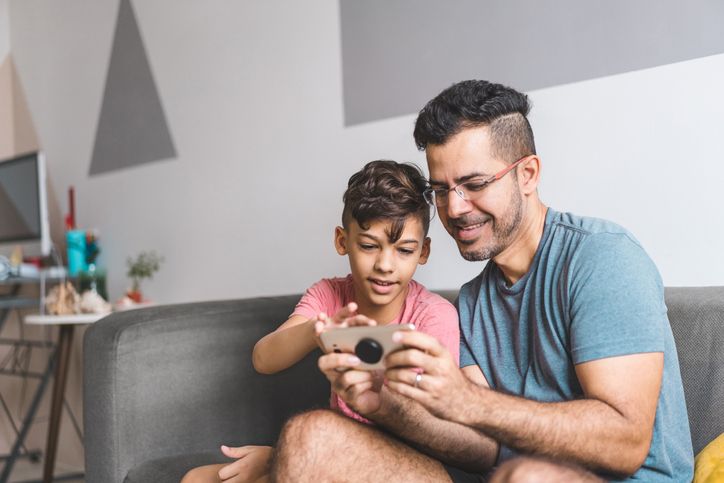Use Your Teen's Cellphone to Keep Them Safe. Here's How

The digital age has given parents new tools for ensuring the safety of their teenagers, and one of these tools is smartphone monitoring. Smartphone monitoring has many benefits that can give parents peace of mind when their teens are out and about; it's an effective way to make sure your teen is safe without invading their privacy.
Using your teen's cell phone to keep them safe involves a combination of setting appropriate boundaries, communication, and leveraging technology.
Whether you're concerned about bullying or risky behavior, this post will share with you how using your teen's cell phone and setting certain cell phone rules (and maybe even creating a cell phone contract your teen can sign) can help protect them from harm. Here are some strategies, tips, and tools to consider for cell phone safety.

Parental Controls and Monitoring Apps
You can install parental control and monitoring apps on your teen or child's cell phone to track their online cell phone use, block anything inappropriate, and limit screen time. These apps can also help you monitor their interactions on chat rooms, social networking sites and receive alerts about potential dangers.
About Parental Controls and Monitoring Apps
Parental controls and monitoring apps are software tools designed to help parents manage and oversee their children's cell phone use online and screen time on smartphones, tablets, and computers. These apps provide a range of features to ensure a safer digital experience for children and teens. Here's a more detailed explanation of these tools:
-Content Filtering:
Parental control apps offer content filtering to block access to inappropriate websites, explicit content (like videos or pictures), or applications with age-inappropriate material. They often use databases and algorithms to identify and block harmful or adult-oriented content.
-Screen Time Management:
These apps allow parents to set daily or weekly screen time limits for specific apps or overall device usage on their children's cell phones. Once the set time limit is reached, the app may restrict access to certain functions or lock the device.
-App Management:
With these features, parents can approve, block, or restrict access to certain applications. This ensures that children only have access to age-appropriate and safe applications on their cell phones.
-Social Media Monitoring:
Parental control apps can monitor social media platforms to track your child's interactions, posts, and messages. This helps parents identify and address potential cyberbullying, online harassment, or inappropriate conversations their kids may be experiencing.

-Location Tracking:
Many applications offer GPS tracking via cell phone, allowing parents to monitor their child's real-time location. This can be particularly useful for ensuring their safety and knowing where they are at any given time.
-Call and Text Monitoring:
Some applications provide the ability to monitor call logs and text messages via cell phone to identify potential issues or unusual communication patterns in cell phone use.
-Geofencing:
Geofencing is a feature that lets parents set virtual boundaries on a map. When the child enters or leaves the defined area, parents receive alerts on their smartphone.
-Panic Button or SOS Feature:
Certain applications include a panic button that, when activated, sends an immediate alert to designated contacts along with the child's location.
-Cyberbullying and Suspicious Content Alerts:
Some advanced monitoring applications use algorithms to detect potentially harmful or cyberbullying content, notifying parents when such content is detected.

-Remote Device Management:
Parental control apps allow parents to remotely manage and configure settings on their child's phone from their own smartphone or computer.
It's important to note that while parental control and monitoring applications can be helpful tools for ensuring online safety, they should be used responsibly and in conjunction with open communication between parents and their teens. Establishing trust and explaining the reasons and ground rules behind using these apps can help teens understand the importance of online safety and responsible device usage.
Some Popular Parental Control and Monitoring Apps
The following are some popular parental control and monitoring apps that have received positive reviews and are commonly used by parents to set limits and keep their child safe. Keep in mind that app features and availability might change over time, so check the latest reviews and ratings before making a decision:

-Qustodio:
Qustodio offers a wide range of features, including content filtering, screen time management, social media monitoring, and geofencing.
-Norton Family:
Norton Family provides web filtering, time management, app monitoring, and location tracking, along with detailed reporting features.
-FamilyTime:
FamilyTime offers a variety of features to protect young people including app blocking, web filtering, location tracking, and geofencing options, as well as the ability to monitor call logs and text messages.

-Net Nanny:
Net Nanny focuses on content filtering, offering robust controls to block inappropriate websites and online content.
-Screen Time Parental Control:
This app is more focused on managing screen time and app usage, allowing parents to set time limits and schedules for their child's device.
-Bark:
Bark is specifically designed for monitoring social media platforms, emails, and texts for signs of cyberbullying, depression, online predators, and other potential risks.
-mSpy:
mSpy offers comprehensive monitoring features, including call tracking, text message monitoring, and location tracking.
-Mobicip:
Mobicip provides content filtering, app management, and time limits to help parents manage their child's online, internet experience.
Before choosing any monitoring app, it's essential to research each one thoroughly to ensure it meets your requirements, is compatible with your teen's device, and aligns with your family's values. Additionally, consider the app's privacy policy and data security measures to safeguard your child's information. Always involve your teen in the decision-making process, explaining the reasons behind using such an app to build trust and encourage responsible digital behavior.
Using GPS Tracking to Keep Track of Your Teen
You can enable location-sharing features to keep track of your teen's whereabouts. Many smartphones have built-in GPS services that allow family members to share their locations with each other. Just make sure to have open communication about the purpose of this feature to respect their privacy.

How to Enable Location-sharing Features
Enabling location-sharing features to keep track of your teen's whereabouts typically involves using the built-in features of their smartphone. Here's a general guide on how to enable location-sharing on both your Android phone and iOS devices.
On Android Devices:
-Google Location Sharing: Most Android devices have Google Location Sharing, which allows users to share their real-time location with selected contacts. To enable it:
a. Open the "Google Maps" app on your teen's android device. b. Tap the hamburger menu (three horizontal lines) in the top-left corner. c. Select "Location sharing" from the menu. d. Choose how long your teen's location should be shared (e.g., "Until you turn this off") and select the contacts you want to share the location with. e. Tap "Share."
-Family Link (For Parental Controls): If you've downloaded and set up the Google Family Link app from the Google Play store to manage your teen's device, you can also use it to track their location. Open the Family Link app on your device to view the location of your teen's device.

On iOS Devices (iPhone/iPad):
-Find My: Apple devices have a feature called "Find My" that allows users to share their location with family and friends. To enable it:
a. Open the "Settings" app on your teen's iPhone or iPad. b. Tap on their Apple ID name at the top. c. Select "Find My" or "Find My iPhone/iPad." d. Ensure that "Share My Location" is turned on. e. Tap "Share My Location" to choose the contacts with whom you want to share the location.
-Family Sharing (For Parental Controls): If you've set up Family Sharing on your Apple devices, you can use it to view your teen's location. Open the "Find My" app on your device to see their location.
Keep in mind that for location-sharing to work, your teen's electronic devices must have an active internet connection, and they need to have the location services (GPS) enabled on their phone. Additionally, make sure to have open and honest conversations with your teen about location-sharing and explain why you want to use this feature to ensure their safety. Respecting their privacy concerns while emphasizing the importance of safety is essential in maintaining a healthy parent-child relationship.
More Tips to Keep Your Teen Safe

Emergency Contacts: Ensure your teen's phone has essential emergency contacts programmed and easily accessible. Teach them when and how to call emergency services if needed.
Set Screen Time Limits: Encourage responsible phone use by setting screen time limits. Many devices now have built-in features to help you monitor and manage screen time.
Educate About Online Safety: Talk to your teen about online safety, including the risks of sharing personal information with strangers, cyberbullying, and the importance of maintaining privacy settings on social media.
Texting and Driving Prevention: Remind your teen of the dangers of texting and driving. Encourage them to use apps or settings that disable texting and notifications while driving.

App and Content Approval: Approve and discuss the apps your teen wants to download. Encourage them to come to you if they encounter any suspicious or inappropriate images or content.
Digital Etiquette and Responsibility: Teach your teen about responsible digital behavior, including the potential consequences of sharing harmful or inappropriate content online.
Open Communication: Keep an open and non-judgmental line of communication with your teen. Encourage them to talk to you about any concerns or issues they may encounter online or offline.

Know Their Online Friends: Familiarize yourself with your teen's online friends and contacts. Encourage them to only connect with people they know in real life.
Password Protection: Help your teen set up strong passwords and use biometric features (e.g., fingerprint, facial recognition) to secure their device.
Remember, using your teen's cell phone to keep them safe online is not about invading their privacy but rather helping them navigate the digital world responsibly. It's essential to strike a balance between protecting them and keeping them safe online and respecting their need for autonomy as they grow and learn to make responsible decisions. Open communication and trust are crucial in this process.
Considering a Remote Management App? Here’s what to Know
Remote management apps, also known as Mobile Device Management (MDM) software, are tools designed to allow administrators (such as parents or organizations) to remotely manage and control mobile devices. These apps are commonly used in businesses and educational institutions to manage company-owned devices or student devices. However, they can also be useful for parents who want to manage their child's device usage and safety. Here's more information about remote management apps:
-Remote Configuration and Settings Management: Remote management apps enable administrators (parents) to configure settings on the target device from a central web-based console. This includes setting up Wi-Fi networks, email accounts, app permissions, and more.

-App and Content Management: With remote management, parents can install or uninstall apps remotely, control app access, and manage content on the device. They can restrict access to certain apps or content deemed inappropriate.
-Location Tracking and Geofencing: Many remote management apps offer location tracking features to monitor the real-time location of the device. Geofencing allows parents to set virtual boundaries and receive alerts when the device enters or leaves those boundaries.
-Screen Time Management: Remote management apps often include screen time management features, allowing parents to set time limits on device usage and schedule screen time for specific hours.
-Content Filtering and Safe Browsing: These apps can block access to harmful or inappropriate content on the internet, providing a safer online experience for children.
-Remote Lock and Wipe: In case of device theft or loss, parents can remotely lock or wipe the device to protect personal information from falling into the wrong hands.
-Monitoring and Reporting: Remote management apps typically provide detailed reports on device usage, app activities, web browsing history, and more. This helps parents keep track of their child's online activities and identify potential issues.

-Device Compliance and Security: For businesses and institutions, remote management apps can ensure that devices meet security standards, enforce password policies, and detect and address potential security threats.
It's important to note that remote management apps typically require proper setup and permissions on the target device. In many cases, these apps are used for managing devices that are owned or provided by an organization or educational institution. When using such apps for parental control, it's crucial to have open communication with your child, explain why you are using the app, and respect their privacy concerns.
Furthermore, some of the features offered by remote management apps may require special permissions on the device, which can vary depending on the operating system (iOS, Android) and version. Always review the app's privacy policy, terms of use, and permissions required before installing it on your child's device.
Now that you're better equipped to keep your teen safe, protect your hard-earned money with free wireless service from Life Wireless!
Posted 9 months ago